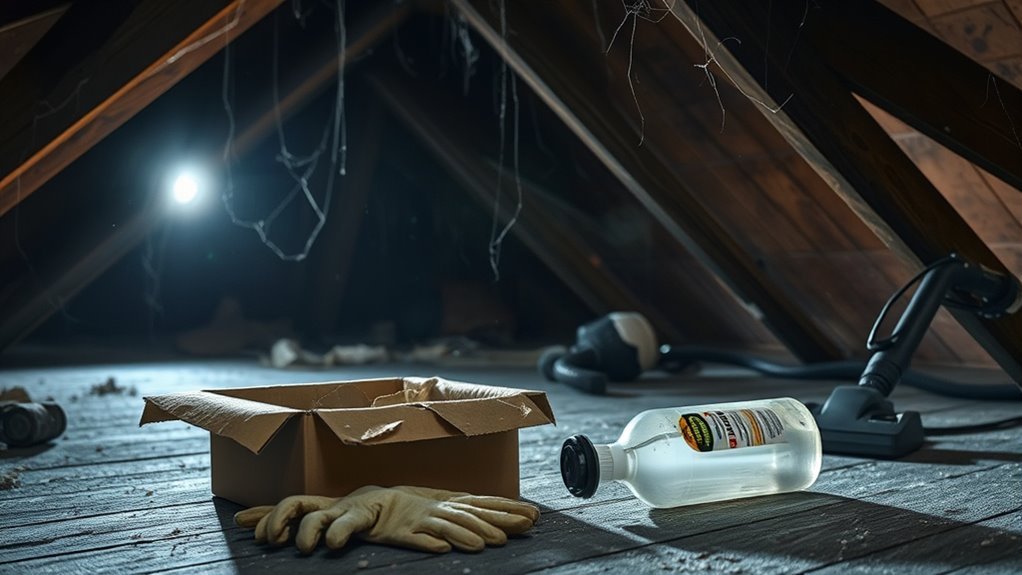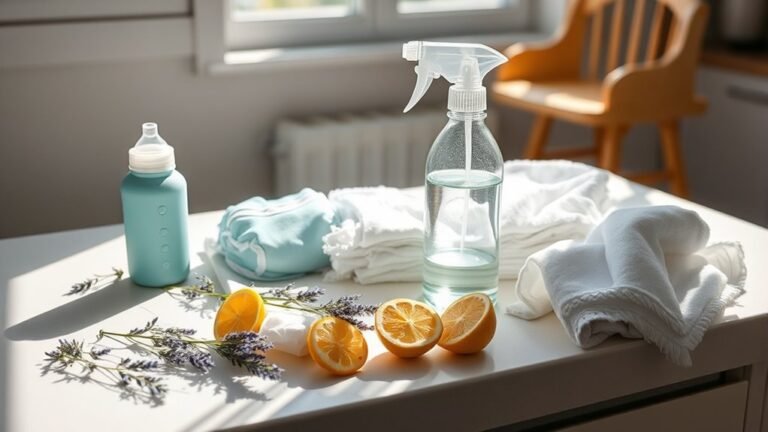Cleaning Mistakes That Damage Your Attic
You’ll damage your attic if you use harsh chemicals that degrade insulation or ignore proper ventilation, which leads to moisture buildup and mold growth. Overlooking mold can cause health risks and structural decay, while mishandling wiring during cleaning puts you at risk of electrical hazards. Skipping regular maintenance lets debris and pests accumulate, making small problems worse. Keep these pitfalls in mind, and you’ll find out how to protect your attic from costly damage.
Using Harsh Chemicals That Harm Insulation
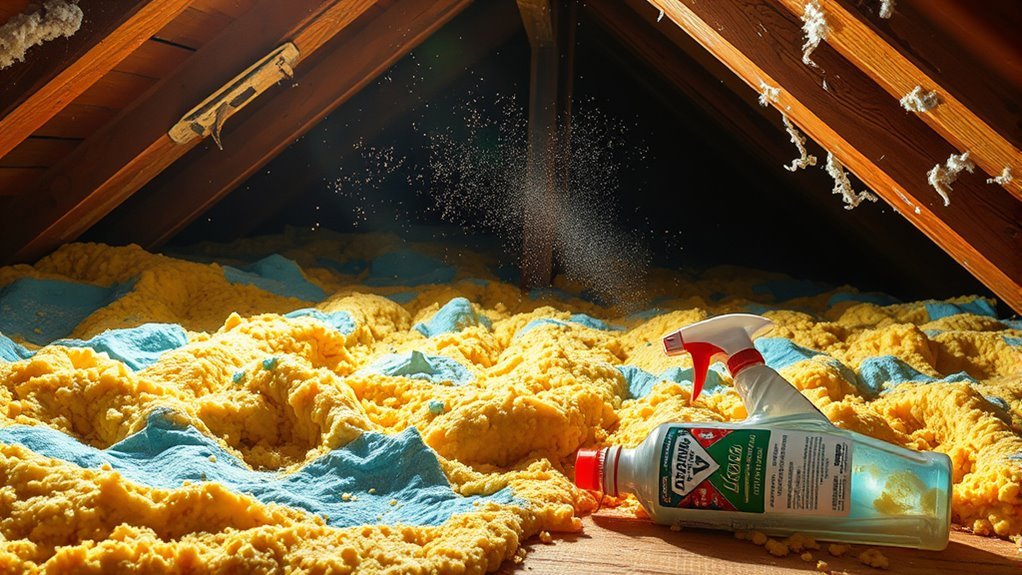
Although it might seem like a good idea to use strong cleaning agents in your attic, harsh chemicals can actually damage the insulation. When you’re aiming to keep your attic clean, remember that protecting your insulation is key to maintaining energy efficiency and comfort. Instead of reaching for aggressive chemical solutions, consider safer chemical alternatives that won’t eat away or degrade the insulating material. These alternatives help you keep your attic fresh without compromising its protective barrier. By choosing gentler options, you free yourself from worrying about costly repairs or reduced energy savings caused by damaged insulation. Staying mindful about what you use guarantees your attic remains a secure, well-insulated space, giving you the freedom to enjoy a comfortable home without unnecessary risks.
Ignoring Proper Ventilation and Airflow
When you overlook proper ventilation and airflow in your attic, moisture can build up and cause serious problems like mold growth and wood rot. Without effective ventilation systems, stale air gets trapped, creating a damp environment that damages insulation and structural components. You want your attic to breathe freely—good airflow management is key to preventing moisture accumulation and maintaining a dry, healthy space. Proper ventilation systems help regulate temperature swings and reduce humidity, which preserves your attic’s integrity over time. Don’t let neglecting airflow turn your attic into a breeding ground for damage. By ensuring your ventilation systems are clean, unobstructed, and functioning well, you take control of your attic’s health and keep it safe from hidden harm.
Overlooking Mold and Mildew Growth
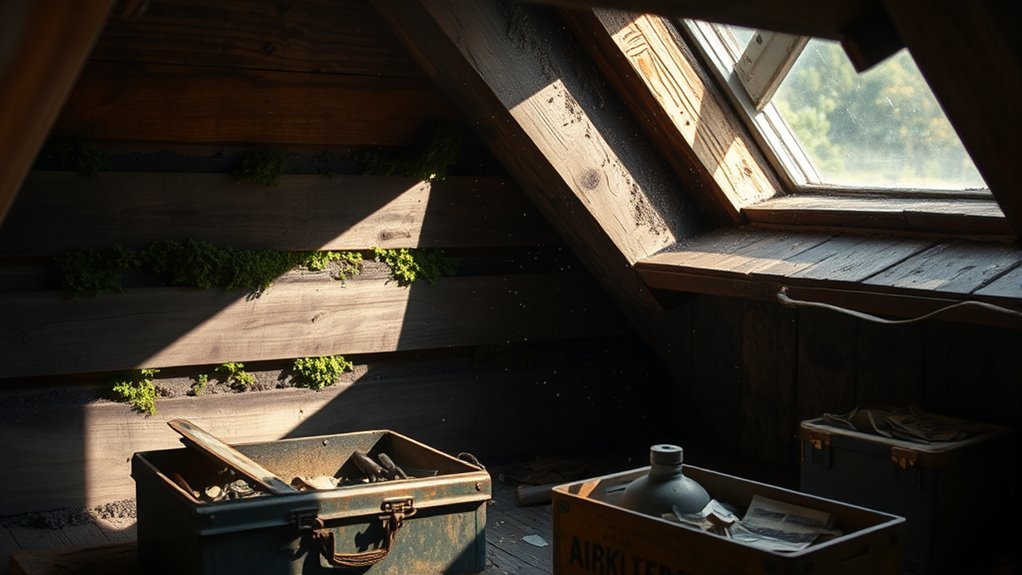
Proper ventilation helps keep moisture at bay, but if you overlook mold and mildew growth, that moisture can still cause serious damage. You might think airing out your attic is enough, but without regular mold detection, hidden spores can thrive, leading to structural decay and health risks. Don’t let mildew sneak in unnoticed—make mildew prevention a priority by inspecting damp spots and using dehumidifiers when necessary. Taking these steps frees you from costly repairs and keeps your attic safe and sound. Remember, spotting mold early isn’t just about cleanliness; it’s about protecting your home’s integrity and your peace of mind. Stay proactive, and you’ll avoid the trap of unseen damage lurking in the shadows of your attic.
Damaging Wiring and Electrical Components
If you’re not careful, cleaning your attic can lead to accidentally damaging wiring and electrical components. When you move insulation or debris, it’s easy to disturb exposed wires or loosen connections. This not only compromises wiring safety but also creates serious electrical hazards that put your home at risk. Avoid touching or pulling on wires, and never use water or wet tools near electrical parts. Instead, opt for dry cleaning methods and keep a safe distance from panels or junction boxes. If you spot damaged wiring, call a professional rather than attempting repairs yourself. Protecting wiring safety guarantees your attic stays safe and your freedom from electrical risks remains intact. Don’t let a simple cleaning task turn into a dangerous situation.
Neglecting Regular Cleaning and Maintenance
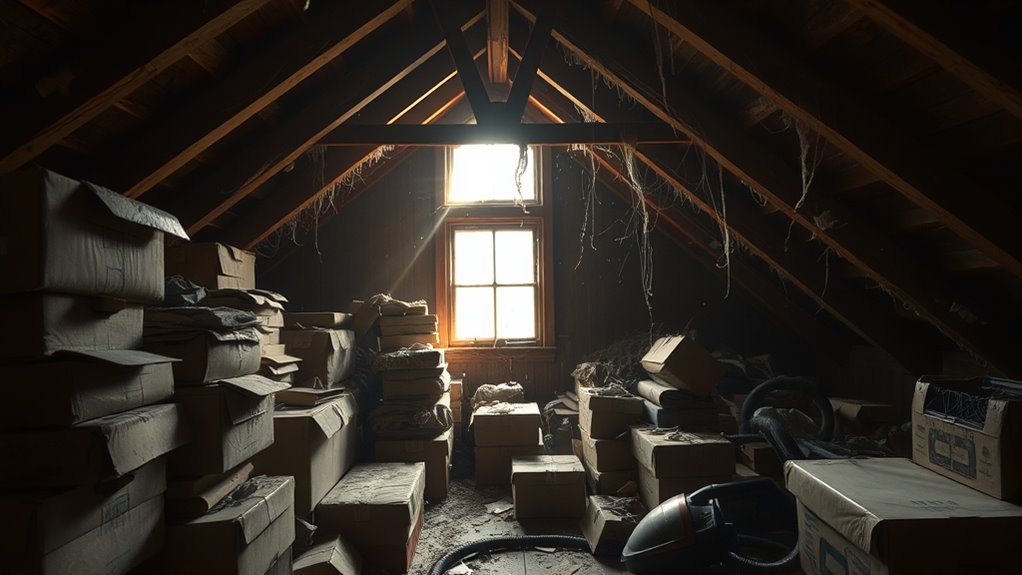
Although it might seem like you can skip it, neglecting regular cleaning and maintenance in your attic can lead to serious problems over time. Skipping regular inspections and seasonal cleaning allows dust, debris, and moisture to build up, creating the perfect environment for mold, pests, and structural damage. You want your attic to stay safe and functional, not a hidden hazard. By committing to scheduled upkeep, you guarantee that small issues don’t spiral into costly repairs. Regular inspections help you spot problems early, while seasonal cleaning keeps your attic fresh and free of clutter. Taking these simple steps gives you the freedom to enjoy your home without unexpected headaches lurking above. Don’t let neglect steal your peace of mind—make attic maintenance a priority.
Frequently Asked Questions
How Often Should I Inspect My Attic for Pests?
You should inspect your attic for pests at least twice a year to keep pest prevention on track. Regular inspection frequency helps you catch problems before they get out of control, giving you peace of mind and the freedom to enjoy your home without worry. If you notice signs of pests or live in a high-risk area, consider checking more often. Staying proactive guarantees your attic stays safe and damage-free.
Can Attic Dust Cause Allergies or Respiratory Issues?
Imagine your attic as a secret space where tiny, invisible guests—attic allergens—love to gather. These uninvited visitors can quietly affect your respiratory health, causing sneezes, congestion, or more serious issues if you’re sensitive. To keep your freedom to breathe easy, it’s wise to regularly check and clean your attic, reducing those allergens. Taking care of this hidden spot means you’re protecting your home’s air quality and your well-being without feeling trapped by unseen irritants.
What Is the Best Lighting for Attic Cleaning?
When cleaning your attic, you’ll want the best lighting to see clearly and avoid missing dust or hazards. LED lights are a top choice since they’re bright, energy-efficient, and produce less heat, making your space safer and cooler. Fluorescent bulbs can work too but tend to flicker and have a shorter lifespan. Opt for LED lighting to give yourself freedom to clean effectively without worrying about poor visibility or frequent bulb changes.
Should I Remove Old Insulation Before Adding New?
You should definitely consider insulation removal before insulation replacement if the old material is damaged, moldy, or compressed. Removing old insulation creates a clean slate, ensuring your new insulation performs at its best. Don’t skip this step, or you might trap moisture or reduce energy efficiency. Taking the time to remove and replace insulation properly gives you the freedom to enjoy a cozy, energy-efficient home without future headaches.
How Do I Safely Store Items in the Attic?
Imagine your attic like a treasure chest—without proper organization, it’s easy to lose precious gems. For safe attic storage, use sturdy storage containers to protect items from dust and pests. Keep heavier boxes near the floor and lighter ones on shelves to avoid accidents. Clear pathways and label everything for easy access. With smart attic organization, you’ll free yourself from clutter chaos and easily find what you need whenever you want.
